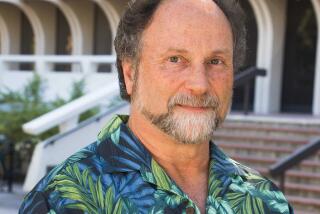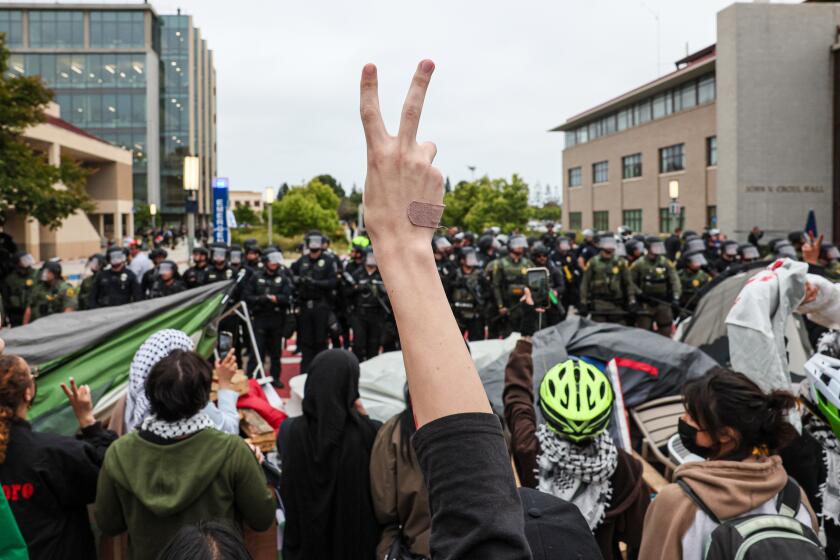Slow-Growth Proposal Is Burbank’s Strongest Yet
The planned-growth ordinance coming before Burbank voters in Tuesday’s city election would, if passed, give residents their loudest voice ever in slowing apartment and condominium construction while increasing red tape for some residential builders.
Strict guidelines called for in the ordinance would force developers to make new residential buildings more visually pleasing and blend better with their surroundings. City officials would also be required to gauge what services and utilities would be needed to accommodate projected growth all over Burbank.
The proposal would not bring development in Burbank to a halt. It covers only residential development and does not address commercial or industrial development.
If adopted, the ordinance would affect only property owners who want to build more units on their land than is allowed under city codes. Such building would be prohibited under the ordinance, and the City Council would be powerless to change a property’s zoning to allow more units for at least four years.
Conversions Barred
For instance, the ordinance would prevent a single-family home on land zoned for one dwelling unit from being converted into a rental duplex. And, of course, the measure would prevent a large apartment complex from being built in a neighborhood zoned only for single-family homes.
But the proposal also contains one possibly unwelcome element. The ordinance could permit an unpopular large residential project to be built regardless of its neighbors’ wishes.
Because the measure allows all Burbank voters a chance to vote on a revised master plan for the city in 1993, a proposed project that is folded into the master plan could be approved by a majority, even though the project’s neighbors oppose it.
Also, the proposal’s opponents--mostly large developers and real estate agents--say it creates just another obstacle in a bureaucracy overloaded with controls on development. They say that growth already has slowed naturally because of the economy and that the ordinance would impose unfair limits on small property owners as well as large developers.
Front-Runners’ Support
The proposal was initiated by Burbank City Councilwoman Mary Lou Howard and is supported by all of the front-runners in a 14-candidate council race that also will be decided Tuesday.
The measure, the top candidates maintain, addresses recent fears that Burbank’s single-family neighborhoods are becoming overrun by noise and pollution from increased development.
If passed, the planned-growth ordinance would go into effect immediately.
City Council members decided in October to put the measure on the ballot to gauge its support. The ordinance could have been adopted by the council and made into law without voter approval but a majority of the council--Mayor Al F. Dossin, Mary E. Kesley and Robert R. Bowne--did not support it then.
Howard and Michael R. Hastings were the only council members who supported the measure. Dossin later backed Howard’s proposal to place the measure on the ballot to put the issue before the voters.
Last week, Dossin, who is running for reelection, said he supported the measure.
Easily Changed
However, the measure is just like any other city ordinance in that it can later be changed--or eliminated--at the whim of the council. City Atty. Douglas C. Holland said any aspect of the ordinance could be weakened or strengthened by a majority vote of the five-member council.
Before Howard introduced her ordinance to the council, Hastings had proposed a similar planned-growth ordinance that contained language to prevent the council from changing the ordinance without a unanimous vote. His proposal also placed a limit on residential development, which the Howard measure stops short of doing.
The council did not support putting Hastings’ measure on the ballot. Although Hastings backs the Howard ordinance, he has repeatedly said it “lacks teeth” because it could be changed so easily.
But Howard maintains that the proposal’s “teeth” can be found in its intent to clamp down on rampant residential growth. Projects that would affect single-family neighborhoods could be closely scrutinized by city officials and the public. In addition, developers and property owners would be given a fair chance in four years to prove that the measure’s restrictions should be relaxed.
The measure would not prevent a homeowner living in a single-family home from building or converting part of his property into an apartment for a family member. That conversion would be covered under an existing “second dwelling unit” ordinance. As long as the homeowner lives in the main residence, he need only apply for a conditional-use permit.
But the same homeowner could not convert his home into a multi-unit rental property if the land were only zoned for a single-family home.
Possible Exceptions
The only exception might be if a developer offered to decrease the number of units on one property to have a higher number of units on another property, said City Planner Rick Pruetz. The builder would have to show that the total number of residential units he was building fell within the accepted limits.
Under the city’s master plan, which was adopted by the council last year, a maximum of about 64,000 residential units--apartments, condominiums and single-family homes--are allowed citywide. Burbank now has about 40,000 residential units.
Pruetz said the city expects an average of 350 units a year to be built over the next 20 years. He based this estimate on what he called cyclical trends in development and economics. He added that the present trend may be artificially fueled by builders developing their properties to beat future limits and controls.
Controversial Projects
The Burbank council has been criticized for its approval of several large residential projects in and around single-family home neighborhoods during the last four years. The projects included a controversial 129-home tract on undeveloped hillside property in the Verdugo Mountains northeast of Burbank and a 249-condominium project being built in an area bounded by Hollywood Way, Verdugo Avenue and Whitnall Highway.
In those cases, as well as others, the council voted to relax zoning restrictions that would have limited development of those properties. The ordinance, if passed, would prevent any such changes or relaxing of restrictions.
The ordinance would also introduce a mechanism allowing city officials to see how well it is working.
The city’s community development director would report to the city’s Planning Board and council by Jan. 1, 1993, on the progress and rate of residential development since the ordinance went into effect. The report could include official recommendations, if any, for increasing the allowed number of residential units throughout the city.
4-Year Action
It won’t be until 1993 that developers who want to make a plea for the council to ease the ordinance’s strict guidelines can make their case. Property owners who want to increase the number of units allowed on their property can make their proposals at that time.
“The council and Planning Board can look at the implications of each proposal, but the focus will be on looking at the total impact of all the proposed changes,” Holland said. “This way, everything is on the table at one time. Rather than taking things on a project-by-project basis, the city will be looking at everything, and how much it will affect services.”
The total impact of the proposals would be evaluated by the Planning Board and City Council, and public hearings would be held. People opposing or supporting a specific proposal in their neighborhood could voice their opinions at these hearings.
Added to Plan
If the council approved the proposed changes, they would be incorporated into the city’s existing land-use plan, which regulates zoning throughout Burbank. That plan, with the revisions, would again be subject to voter approval.
Holland said a colored map highlighting all the proposed zoning changes and residential unit increases, along with a summary sheet detailing the planned revisions, would be sent to voters with their sample ballots. A copy of the land-use plan, which is now about 16 pages, would be available at libraries and City Hall.
Holland said he felt that concerned voters would take the time to educate themselves about the revisions. “I don’t believe there will be that much that people would have to absorb,” he said. “There was more reading involved with last November’s election when all the insurance initiatives were on the ballot.”
If one proposed project were vehemently opposed by one neighborhood, it could still be approved by a majority of voters as part of the land-use plan, Holland said. But if voters cast their ballots against the plan because of the unpopularity of one or more proposed changes in zoning, the council could eliminate those changes from the plan and resubmit it to voters.
Dealing With Growth
“Through the political process, the council will get a sense of what’s acceptable to residents and what isn’t,” Holland said.
The election on the revised land-use plan would be held no later than Dec. 1, 1993, and, if approved by voters, the plan would become effective no later than Jan. 1, 1994. Further zoning increases would be prohibited until Jan. 1, 2000.
One thing that the ordinance would also do is increase the red tape for anyone who wanted to build more than a single-family home in Burbank.
It is relatively easy for a property owner to build more than two residential units on his property if the proposed project fits the zoning. A builder can submit plans for such a project without applying for a conditional-use permit.
Strict Guidelines
But the ordinance would require that property owner to adhere to strict environmental and architectural standards for any proposed project of two units or more. Those standards are now being determined by a consultant and are expected to be adopted by the council by July 1.
Among the standards that builders would have to address are the architectural design, landscaping and traffic circulation.
During the period between the effective date of the ordinance and the adoption of the new standards, property owners who want to build two or more units must apply for conditional-use permits, even though the project may be allowable under the property’s zoning. The process would include public hearings before the Planning Board.
After the new standards are adopted, it would again become easier for a builder of two units or more to build his project if it meets those standards.
Other Considerations
More than the number of residential units would be scrutinized by city officials under the ordinance.
The city’s community development director will evaluate the level of city services, such as utilities, that would be needed to accommodate planned commercial, industrial and residential development throughout Burbank.
That report would also come before the City Council and Planning Board for adoption, and the public would have an opportunity to voice its opinion on whether the services will be adequate.
The ordinance would also require officials to take into account a proposed project’s compatibility with the neighborhood, and its impact on public services and utilities, as well as the financial impact on the city and taxpayers to provide services and utilities to the project. The project would also have to meet state environmental standards.
Curbing Impact
Before a project could be approved, the Planning Board would have to make sure that the property owner had reduced or eliminated any negative aspects that might affect the surrounding neighborhood.
Opponents of the ordinance say it is not needed because the construction of buildings with two or more units has already slowed. They added that the council last year adopted three measures that addressed concerns about development and established controls.
They also claimed that the law would prohibit the rehabilitation of blighted areas and prevent the reconstruction of existing buildings destroyed by fire, earthquakes or other causes. But Pruetz said no reconstruction would be denied as long as the units within the proposed building were consistent with the property’s zoning.
More to Read
Sign up for Essential California
The most important California stories and recommendations in your inbox every morning.
You may occasionally receive promotional content from the Los Angeles Times.











